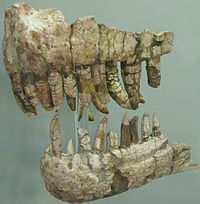- Cerro Barcino Formation
-
Cerro Barcino Formation
Stratigraphic range: Hauterivian–CampanianType Geological formation Unit of Chubut Group Sub-units Puesto Manuel Arce
Bayo Overo
Las Plumas
Cerro Castaño
La PalomaUnderlies La Colonia Formation, Paso de Sapo Formation, Lefipan Formation Overlies Los Adobes Formation Location Region Chubut Province Country  Argentina
ArgentinaThe Cerro Barcino Formation (also known as the Gorro Frigio Formation) is a geological formation in South America whose strata span the mid-late Cretaceous period. Dinosaur remains are among the fossils that have been recovered from the formation.[1]
The Cerro Barcino Formation is the upper unit of the Chubut Group, which also includes the older Los Adobes Formation. Both formations cover a vast area in Chubut Province, Argentina. The two formations are distinguished by geological features suggesting a distinct change in climate, from a wetter, flood plain environment in the Los Adobes to a much more arid, desert-like environment in the Cerro Barcino.[2]
The Cerro Barcino Formation is subdivided into several subunits ("members").[2] From oldest to youngest:
- La Paloma
- Characterized by arid plains interspersed with sand dunes
- Cerro Castaño
- A return to more humid, flood-plain conditions
- Las Plumas
- Bayo Overo
- Puesto Manuel Arce
The final three members are likely Albian to Campanian in age (112 to 83 million years ago), while the La Paloma may date to the latest Hauterivian (130ma).[2]
Contents
Fauna
Indeterminate abelisaurid remains.[1] Possible indeterminate carcharodontosaurid remains.[1] Indeterminate Titanosauria remains.[1] Also, an unnamed titanosauriform.[1]
Crurotarsans
Color key
Taxon Reclassified taxon Taxon falsely reported as present Discredited taxon Ichnotaxon Ootaxon Morphotaxon Notes
Uncertain or tentative data are in small text;crossed outdata are discredited.Crocodylomorphs of the Adamantina Formation Genus Species Location Stratigraphic position Material Notes Images Barcinosuchus[3]
B. gradilis
Near El Escorial village, Chubut Province.
Cerro Castaño Member.
"Skull, mandible, and postcranial remains."
A peirosaurid. The first crocodyliform from the Chubut Group.
Dinosaurs
Dinosaurs of the Cerro Barcino Formation Genus Species Presence Material Notes Images Chubutisaurus insignis
Present in the Bayo Overo Member.[citation needed]
"[Two] partial skeletons including most limb elements and caudal vertebrae."[4]
Genyodectes serus
Present in the Cerro Castaño Member.[5]
"Premaxillae, partial dentaries."[6]
A possible ceratosaurid.
"Megalosaurus"
"Megalosaurus" inexpectatus
Indeterminate remains originally described as a species of Megalosaurus.[1]
Tyrannotitan chubutensis
Present in the Cerro Castaño Member.
See also
References
- ^ a b c d e f g Weishampel, David B; et al. (2004). "Dinosaur distribution (Early Cretaceous, South America)." In: Weishampel, David B.; Dodson, Peter; and Osmólska, Halszka (eds.): The Dinosauria, 2nd, Berkeley: University of California Press. Pp. 563-570. ISBN 0-520-24209-2.
- ^ a b c Rauhut, O.W.M., Cladera, G., Vickers-Rich, P. and Rich, T.H. (2003). "Dinosaur remains from the Lower Cretaceous of the Chubut Group, Argentina." Cretaceous Research, 24(5): 487-497. doi:10.1016/S0195-6671(03)00067-3
- ^ Juan Martín Leardi and Diego Pol (2009). "The first crocodyliform from the Chubut Group (Chubut Province, Argentina) and its phylogenetic position within basal Mesoeucrocodylia". Cretaceous Research 30 (6): 1376–1386. doi:10.1016/j.cretres.2009.08.002.
- ^ "Table 13.1," in Weishampel, et al. (2004). Page 268.
- ^ Rauhut, O.W.M. (2004). Provenance and anatomy of Genyodectes serus, a large-toothed ceratosaur (Dinosauria: Theropoda) from Patagonia. Journal of Vertebrate Paleontology 24(4):894-902.
- ^ "Table 3.1," in Weishampel, et al. (2004). Page 50.
- ^ Novas, F. E.; S. de Valais, P. Vickers-Rich, and T. Rich (2005). "A large Cretaceous theropod from Patagonia, Argentina, and the evolution of carcharodontosaurids". Naturwissenschaften 92 (5): 226–230. doi:10.1007/s00114-005-0623-3. PMID 15834691.
Categories:- Cretaceous paleontological sites of South America
- La Paloma
Wikimedia Foundation. 2010.

